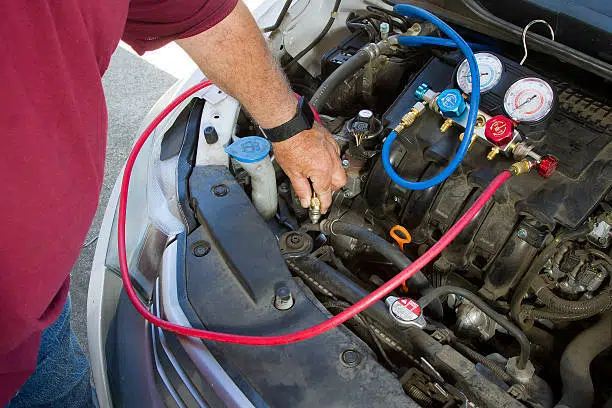
Table of Contents
As the summer heat sets in, ensuring your air conditioning system is in peak condition becomes a top priority. Regular maintenance of your air conditioner is crucial not only for maintaining comfort but also for enhancing efficiency, prolonging the system’s lifespan, and saving on energy costs. At HVAC Service Solutions, we understand the importance of keeping your cooling system in excellent shape. This comprehensive guide outlines a detailed maintenance schedule and checklist to help you stay on top of your air conditioner’s upkeep.
What Should You Know About Your Air Conditioner
Before diving into the specifics of maintenance, it’s essential to understand the basic components and types of air conditioners. The main types include central air conditioners, ductless mini-split systems, window units, and portable units. Each type has unique features and maintenance needs.
The key components of an air conditioning system are the compressor, condenser, evaporator, and expansion valve. The compressor and condenser are typically located outside the house, while the evaporator is inside. The compressor pressurizes the refrigerant, which then travels through the condenser to release heat outside. The cooled refrigerant moves to the evaporator, where it absorbs heat from the indoor air, providing cooling. The expansion valve regulates the refrigerant flow into the evaporator.
Understanding these components helps in recognizing potential issues and performing basic air conditioner maintenance tasks effectively.
Maintenance Schedule

A well-structured air conditioner maintenance schedule is vital for keeping your air conditioner running smoothly. Here’s a breakdown of the tasks you should perform monthly, quarterly, biannually, and annually.
Monthly Tasks
- Checking and Cleaning Air Filters: Dirty filters can obstruct airflow and reduce efficiency. Depending on your usage and the filter type, clean or replace filters monthly.
- Inspecting the Thermostat: Ensure the thermostat is functioning correctly and maintaining the desired temperature. Consider upgrading to a programmable thermostat for better control.
- Ensuring Proper Airflow: Check that all vents and registers are unobstructed and clean. Listen for unusual noises that could indicate problems.
Quarterly Tasks
- Cleaning the Exterior Unit: Remove debris, leaves, and dirt from the condenser unit. Trim any vegetation around the unit to ensure proper airflow.
- Checking Refrigerant Levels: Low refrigerant levels can indicate a leak and reduce cooling efficiency. If you notice decreased cooling performance, contact a professional to check and refill the refrigerant.
- Inspecting Ductwork for Leaks: Examine visible ductwork for signs of leaks or damage. Properly sealed ducts ensure efficient airflow and energy savings.
Biannual Tasks
- Professional Inspection and Servicing: Schedule a professional maintenance check in spring and fall. This ensures your system is ready for the peak cooling and heating seasons.
- Cleaning Evaporator and Condenser Coils: Dirty coils reduce the system’s efficiency. A professional technician can clean these coils to maintain optimal performance.
- Testing Electrical Components: Ensure all electrical connections are secure and components are functioning correctly. This includes checking safety switches and capacitors.
Annual Tasks
- Deep Cleaning and Servicing Before Peak Seasons: A comprehensive cleaning and servicing before summer and winter ensure your system operates efficiently.
- Comprehensive System Check by a Professional Technician: An annual check covers all aspects of the system, identifying potential issues before they become major problems.
Check out the most common air conditioning problems and how to solve them yourself in our previous article via the link below.
https://thehvacservice.ca/how-to-fix-the-most-common-air-conditioning-problems-by-yourself/
Detailed Air Conditioner Maintenance Checklist
Maintaining your air conditioner involves various tasks that ensure all components work efficiently. Here’s a detailed air conditioner maintenance checklist to guide you through the process.
Monthly Maintenance
- Air Filter: Check the air filter every month and clean or replace it as needed. Clogged filters restrict airflow, reducing efficiency and increasing energy consumption. Use high-quality filters and follow the manufacturer’s recommendations for replacement. If you have pets or live in a dusty area, you might need to check and replace filters more frequently.
- Thermostat: Verify that the thermostat is accurate and responsive. Replace the batteries if necessary and consider upgrading to a programmable or smart thermostat for better energy management. Test the thermostat by setting it to a temperature lower than the current room temperature and listen for the AC to turn on. If it doesn’t respond correctly, it may need recalibration or replacement.
- Airflow: Ensure all vents and registers are open and unobstructed. Regularly clean them to prevent dust and debris buildup. Listen for any unusual noises that might indicate a problem with the fan or motor. Check for proper airflow in each room, and if some rooms are cooler or warmer than others, it may indicate an issue with the ductwork or system balance.
Quarterly Maintenance
- Exterior Unit: Turn off the power and clean the condenser unit. Remove any debris, leaves, and dirt from the exterior and interior of the unit. Trim any vegetation around the unit to maintain at least two feet of clearance on all sides. Ensure the unit is level on its base, as an uneven surface can cause strain on the compressor and other components.
- Refrigerant Levels: Check for signs of low refrigerant, such as diminished cooling performance or ice on the refrigerant lines. Low refrigerant often indicates a leak, which requires professional attention. Do not attempt to refill refrigerant yourself, as this must be done by a certified technician. Regularly inspect the refrigerant lines for visible signs of wear or damage.
- Ductwork: Inspect accessible ductwork for leaks, loose connections, or damage. Sealing leaks can significantly improve your system’s efficiency. Use duct mastic or metal tape for sealing, avoiding duct tape as it can degrade over time. Consider having a professional perform a blower door test to identify hidden leaks and improve overall system efficiency.
Biannual Maintenance
- Professional Inspection: Schedule a professional inspection twice a year. Technicians from HVAC Service Solutions will perform a comprehensive check, including cleaning, testing, and ensuring all components are in good working order. They will check the system’s overall performance, inspect the blower motor and belts, and calibrate the thermostat if necessary.
- Coils Cleaning: The evaporator and condenser coils should be cleaned biannually to maintain efficient heat exchange. A technician will remove dirt and debris from the coils, which can accumulate and reduce efficiency. Dirty coils can cause the system to overheat and fail prematurely, so regular cleaning is essential.
- Electrical Components: Check all electrical connections and components. A professional technician will ensure safety switches, capacitors, and other electrical parts are functioning correctly, preventing potential hazards. They will also inspect the control box, wiring, and connections for signs of wear or corrosion, ensuring the system operates safely and reliably.
Annual Maintenance
- Deep Cleaning: Before the peak cooling season, perform a deep cleaning of the entire system. This includes cleaning the blower assembly, checking the condensate drain, and inspecting all system components for wear and tear. A thorough cleaning ensures the system runs efficiently and reduces the risk of unexpected breakdowns.
- System Check: An annual system check by a professional covers all aspects of your air conditioner. This comprehensive inspection identifies and addresses any issues before they escalate, ensuring your system operates at peak performance. The technician will also check the system’s refrigerant charge, inspect the ductwork for air leaks, and verify that all safety controls are functioning correctly.
DIY vs. Professional Maintenance
Maintaining your air conditioner involves both DIY tasks and professional services. Understanding what you can handle and when to call in a professional is crucial for optimal maintenance. Here’s a comparison to help you decide which tasks are suitable for DIY and which require professional attention.
Maintenance Task | DIY Tasks | Professional Tasks |
|---|---|---|
Air Filter Replacement | Easily done by homeowners; improves air quality and efficiency. | – |
Thermostat Checks | Simple task for homeowners; ensures comfort. | – |
Basic Cleaning | Homeowners can clean the exterior unit and vents to prevent debris buildup. | – |
Refrigerant Handling | – | Only certified technicians should handle refrigerant for safety and efficiency. |
Electrical Inspections | – | Professionals ensure electrical components are safe and functional. |
Comprehensive System Checks | – | Technicians perform thorough inspections to identify and fix hidden issues. |
Opting for professional air conditioner maintenance ensures that all aspects of your system are covered, providing peace of mind and optimal performance. While DIY tasks can help maintain basic functionality, professional services are essential for in-depth maintenance and repairs.
At HVAC Service Solutions, we pride ourselves on delivering top-notch air conditioner maintenance services across Canada.We offer various AC maintenance plans tailored to your needs. Our plans include regular inspections, cleaning, and servicing, ensuring your system remains efficient and reliable throughout the year. By subscribing to an AC maintenance plan, you benefit from priority service, discounted rates, and the peace of mind that comes with knowing your system is well-maintained.
Conclusion
Regular air conditioner maintenance is essential for optimal performance, energy efficiency, and longevity. By following the air conditioner maintenance schedule and checklist provided, you can ensure your system runs smoothly and efficiently. Remember, while some tasks can be done by homeowners, professional maintenance is crucial for comprehensive care.
At HVAC Service Solutions, we are committed to providing exceptional service and helping you keep your air conditioner in top shape. Schedule your next air conditioner maintenance service with us and experience the benefits of a well-maintained air conditioning system.
Frequent Asked Questions
Why is regular air conditioner maintenance important?
Regular air conditioner maintenance is crucial for several reasons. Firstly, it ensures that your system operates at peak efficiency, which can significantly reduce energy consumption and lower utility bills. Proper maintenance also extends the lifespan of your air conditioner by preventing wear and tear on critical components. Additionally, regular check-ups help identify and address minor issues before they become major, costly repairs. Maintenance also improves indoor air quality by keeping filters and coils clean, reducing the amount of dust and allergens circulating in your home. Furthermore, a well-maintained system is less likely to break down unexpectedly, providing peace of mind and consistent comfort. Lastly, many manufacturers require regular maintenance to keep warranties valid.
How often should I change my air filter?
Air filters should be checked and replaced or cleaned every month, especially during peak usage seasons. Dirty filters can restrict airflow, forcing the system to work harder and reducing its efficiency. If you have pets, live in a dusty area, or have family members with allergies or respiratory conditions, you may need to replace filters more frequently. High-efficiency filters, while more expensive, can capture smaller particles and may require less frequent changing. Always follow the manufacturer’s recommendations for your specific system. Additionally, using high-quality filters can improve indoor air quality and extend the life of your air conditioner. Regular filter maintenance is one of the simplest yet most effective ways to ensure your system runs efficiently.
What are the signs that my air conditioner needs professional maintenance?
Several indicators suggest that your air conditioner needs professional maintenance. If you notice a significant drop in cooling performance, such as the system not reaching the set temperature or rooms cooling unevenly, it’s a clear sign. Unusual noises, like grinding, squealing, or banging, can indicate mechanical issues that need attention. Higher energy bills without a change in usage patterns suggest the system is working harder than it should. Frequent cycling on and off, known as short cycling, often points to issues with the thermostat or other components. Ice formation on refrigerant lines or the unit itself typically indicates a refrigerant leak or airflow problem. Additionally, if you experience weak airflow from the vents, it could be due to blockages or a failing compressor. Any of these signs warrant a call to a professional technician for a thorough inspection and necessary repairs.
Can I perform air conditioner maintenance myself?
Yes, there are several maintenance tasks that homeowners can perform themselves to keep their air conditioner in good working order. Replacing or cleaning air filters monthly is one of the easiest and most effective tasks. Checking the thermostat settings and replacing batteries ensures the system operates correctly. Cleaning the exterior condenser unit by removing debris and ensuring proper airflow can prevent overheating and improve efficiency. Homeowners can also inspect and clean vents and registers inside the home to maintain good airflow. However, more complex tasks such as refrigerant handling, electrical inspections, and comprehensive system checks should be left to professionals. Attempting these tasks without proper training can be dangerous and may void the system’s warranty. Regular DIY maintenance complements professional services to keep the system running efficiently.
How often should I schedule professional air conditioner maintenance?
It is recommended to schedule professional air conditioner maintenance at least twice a year. Ideally, this should be done in the spring and fall, before the peak cooling and heating seasons. Spring maintenance ensures that your system is ready for the summer heat, while fall maintenance prepares it for winter. Regular professional check-ups help identify potential issues early, preventing unexpected breakdowns during extreme weather. These biannual inspections typically include cleaning and inspecting coils, checking refrigerant levels, and testing electrical components. Additionally, professional maintenance helps maintain the manufacturer’s warranty and extends the lifespan of your air conditioner. Consistent maintenance ensures that your system operates efficiently year-round, providing optimal comfort and energy savings.
What does a professional air conditioner maintenance service include?
A professional air conditioner maintenance service is comprehensive and covers several critical areas to ensure your system runs efficiently. Technicians will inspect and clean the evaporator and condenser coils, which can become dirty and reduce efficiency. They will also check and adjust refrigerant levels, ensuring optimal cooling performance and identifying any leaks. Electrical components, such as capacitors and contactors, will be tested and tightened to prevent malfunctions. The service includes cleaning and inspecting the blower motor and fan to ensure proper airflow. Additionally, technicians will check the thermostat for accuracy and calibrate it if necessary. They will also clear and inspect the condensate drain to prevent water damage and mold growth. Overall, a professional maintenance service addresses both current issues and potential problems, ensuring your system operates at its best.
What is an air conditioner maintenance checklist?
An air conditioner maintenance checklist is a detailed guide that outlines the tasks needed to maintain your AC system. It typically includes monthly, quarterly, biannual, and annual tasks to ensure comprehensive maintenance. Monthly tasks often involve checking and replacing air filters, inspecting the thermostat, and ensuring proper airflow through vents. Quarterly tasks might include cleaning the exterior unit, checking refrigerant levels, and inspecting ductwork for leaks. Biannual tasks usually involve professional inspections, cleaning of evaporator and condenser coils, and testing electrical components. Annual tasks often include a deep cleaning of the entire system and a comprehensive system check by a professional. Following a maintenance checklist helps prevent major issues, improve efficiency, and extend the lifespan of your air conditioner. It also ensures that maintenance tasks are performed consistently and thoroughly.
Why should refrigerant levels be checked by a professional?
Refrigerant levels should always be checked by a professional due to the complexity and safety risks involved. Handling refrigerant requires specialized knowledge and certification because it involves dealing with high-pressure systems and potentially hazardous chemicals. Improper handling can lead to system damage, personal injury, or environmental harm. A professional technician can accurately measure refrigerant levels, identify leaks, and perform necessary repairs. Correct refrigerant levels are crucial for efficient cooling performance and energy efficiency. Additionally, recharging refrigerant must be done according to the manufacturer’s specifications to avoid overcharging or undercharging, which can damage the system. Professionals have the tools and expertise to safely and effectively manage refrigerant levels, ensuring your air conditioner operates optimally.
How can I improve the efficiency of my air conditioner?
Improving the efficiency of your air conditioner involves several proactive steps. Regularly replacing or cleaning air filters ensures unobstructed airflow and optimal performance. Keeping the exterior unit free from debris and ensuring proper airflow around it helps prevent overheating. Upgrading to a programmable or smart thermostat allows for better temperature management and energy savings. Ensuring that all vents and registers are open and unobstructed maintains efficient airflow throughout your home. Scheduling professional maintenance twice a year ensures that all components are clean and functioning correctly. Additionally, sealing any leaks in ductwork can prevent cooled air from escaping, improving overall efficiency. Implementing these measures can significantly enhance your air conditioner’s performance and reduce energy consumption.
What should I do if my air conditioner is not cooling properly?
If your air conditioner is not cooling properly, start by checking the air filter and replacing it if it’s dirty. Ensure that the thermostat is set to the correct temperature and mode (cooling) and that it’s functioning properly. Check that all vents and registers are open and unobstructed to allow for proper airflow. If these steps don’t resolve the issue, inspect the exterior unit for debris or obstructions and clean it as needed. Listen for any unusual noises that might indicate a mechanical issue. If the problem persists, contact a professional technician to diagnose and fix the issue. Low refrigerant levels, electrical problems, or a failing compressor could be the cause, and these require professional attention to resolve.
Share



















